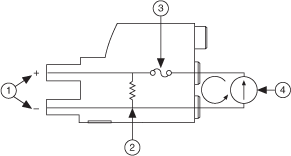Measuring Current
This section describes how to measure current on National Instruments DMMs.
Measuring Current Within the Normal Range (NI 4050 is not supported)
To configure current measurements within the normal range on the NI 4060, the NI 4065, and the NI 4070/4071/4072, use one of the following two methods:
| Method 1 |
- Select the current measurement function.
- Take a reading from the NI 4060, the NI 4065, or the NI 4070/4071/4072 immediately.
|
| Method 2 |
- Configure the DMM for a software trigger.
- Initiate the DMM for a current measurement to cause the input relay to switch.
- Send a software trigger to the DMM to take a measurement.
|
Using Current Shunt Modules
When taking current measurements outside of the specified range on the DMM, and when taking any current measurements on the NI 4050, you must use a current shunt module. NI offers the NI CSM-10A and the NI CSM-200mA current shunt modules. The NI CSM-10A has a 0.01 Ω sense resistor, and the NI CSM-200mA has a 1.0 Ω sense resistor.
 |
Note For the valid current ranges on the NI 4060/4065 and NI 4070/4071/4072, refer to Related Documentation for the specifications documents. |
Each current shunt module (CSM) operates by passing the input current through a precise resistor. The following figure shows the internal circuitry of the CSM:

| 1 Voltage Across Resistor (VOUT) |
3 Fuse |
| 2 Precision Resistor |
4 Current Source (IIN) |
To configure current measurements using the NI CSM-200mA or the NI CSM-10A, perform one of the following two methods:
| Method 1 |
 |
Note This method is valid for all National Instruments DMMs. Use the NI CSM-10A current shunt with the NI 4060/4065 or NI 4070/4071/4072. Use the NI CSM-10A current shunt or the NI CSM-200mA current shunt with the NI 4050. |
- Measure the voltage drop across the resistor of the CSM.
- Use this value to calculate the current using Ohm's Law, as follows:
IIN = (VOUT)/R
where
I is the input current
V is the voltage across the precision resistor
R is the resistance of the precision resistor
For example, assume that you are using the CSM-200mA, which has a 1 Ω precision resistor, and the measured voltage is 50 mV. Apply these values to Ohm's Law to determine the current, as follows:
50 mA = 50 mV / 1 Ω
|

